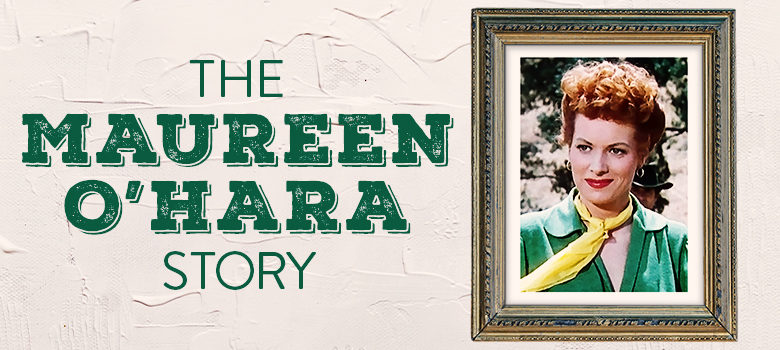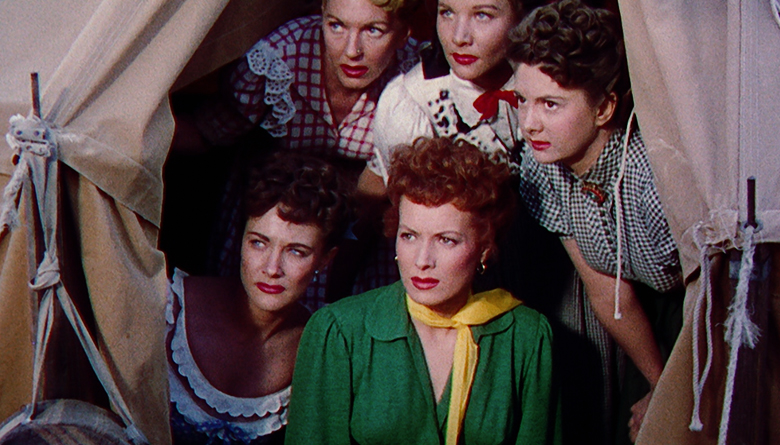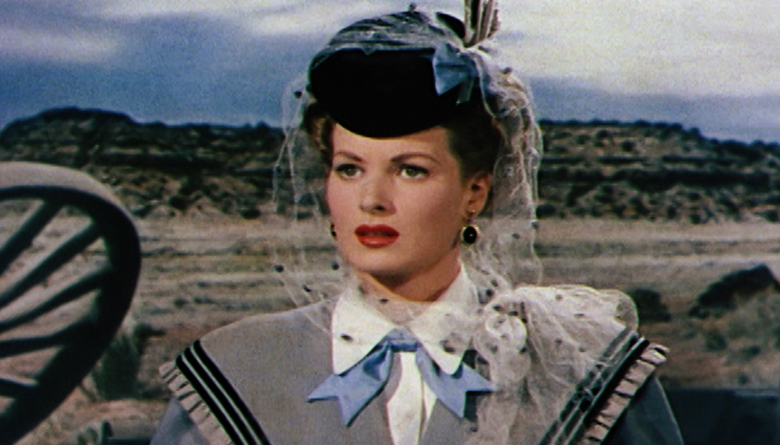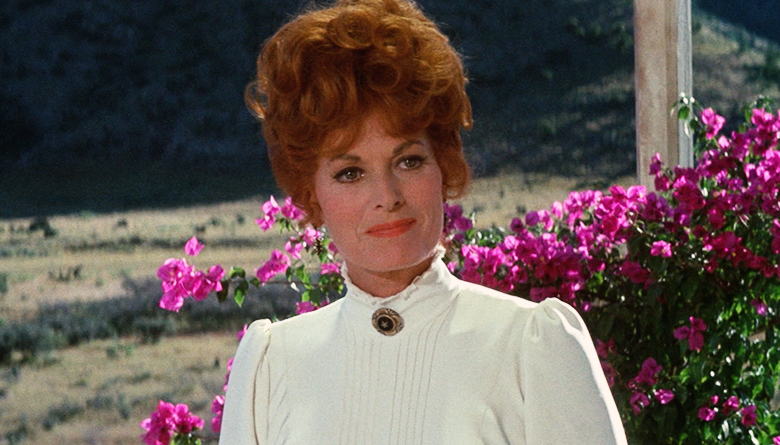The Maureen O’Hara Story

Maureen O’Hara: Her Rise to Hollywood Royalty
With her flaming red hair and her spitfire personality, Maureen O’Hara lit up the big screen co-starring opposite some of Hollywood’s most dynamic and dashing leading men—from Jimmy Stewart to Henry Fonda to her electric performances with her good friend, John Wayne, who famously said of his independent leading lady:
“There’s only one woman who has been my friend over the years, and by that, I mean a real friend, like a man would be. That woman is Maureen O’Hara. She’s big, lusty, absolutely marvelous—definitely my kind of woman. She’s a great guy. I’ve had many friends, and I prefer the company of men. Except for Maureen O’Hara.”
The Road from The Emerald Isle to Tinseltown
Maureen FitzSimmons was born on August 17, 1920, in a Dublin suburb, the second of six children and the only one with red hair. Her father was in business and part owner of The Shamrock Rovers, a well-known soccer team, and her mother was a former singer and actress, whose beauty was praised throughout Ireland.
Her parents were devout Catholics, and all the FitzSimmons children were raised with a strict moral code. In fact, Maureen’s older sister, Peggy, became a nun. But their parents’ traditional ethics didn’t keep the FitzSimmons clan from having fun. All the children participated in the arts. Of her family and upbringing, Maureen once said, she was born into “…the most remarkable and eccentric family I could have possibly hoped for.”
Soccer Field or Stage?
Young Maureen displayed gifts inherited from both parents. She played sports rough like a boy and urged her father to start a women’s soccer team. As a teenager, she studied Judo. She was also drawn to the arts, studying dance, drama, and music. But I was clear where her heart belonged.
When she was 10, Maureen joined the Rathmines Theatre Company and took part in plays and pantomimes after school. At this early age her dream was to star on stage, and when a fortune teller predicted she would be rich and famous, Maureen boasted she would become the most famous actress in the world. At 14, she joined the famed Abbey Theatre, and a year later, it seemed she was well on her way. She won the Dublin Feis Award for her portrayal of Portia in Shakespeare’s The Merchant of Venice.

Two years later, a fellow actor suggested she go to London for a movie screen test and pursue a career as a film actress. Chaperoned by her mother, the bold, outspoken 17-year-old arrived at Elstree Studios ready for her close up, but the test was a disaster. The studio staff caked on makeup and costumed Maureen in a gold lamé dress with long, wing-like sleeves. Her only direction was to walk in and pick up the telephone. Cut. And that’s a wrap. She was mortified at the entire experience. But actor Charles Laughton saw through the layers of foundation, the exaggerated hair piled high, and the gaudy gown. A split second in ideal light revealed to him Maureen’s beauty, her expressive eyes and talent. He and business partner Erich Pommer offered Maureen a seven-year contract with their new company, Mayflower Pictures. Though she was still a teen, her family agreed to let her follow her dreams.
The Beginning of an Illustrious Career
After making a couple of minor films, Laughton, now her mentor, convinced Maureen to change her last name to something shorter. Reluctantly, she settled on O’Hara. He then suggested her for the role of Mary Yelland, opposite him in Alfred Hitchcock’s 1939 film, Jamaica Inn. Though the film opened to lukewarm reviews, critics recognized Maureen for her performance. That same year found Maureen, her mother and Laughton boarding a ship for America, the final destination: Hollywood, where she would, once again, star opposite Laughton in The Hunchback of Notre Dame.
Parting of the Ways
When World War II broke out, Laughton shuttered his company in London and sold Maureen’s contract to RKO. Maureen made a series of forgettable films, endured bullying, devastating reviews, and sexual harassment by one director, whom she punched in the jaw in defense, but gained a lifelong friend in Lucille Ball, despite initially feeling intimidated by the famous comedienne.
Frustrated, Maureen was ready to quit. She begged her agent for a chance at even the smallest role in John Ford’s next movie, How Green Was My Valley. She beat out Katherine Hepburn and Gene Tierney for the co-starring role of Angharad, the daughter of a Welsh coal mining family. The Academy Award winning film not only garnered Maureen well-deserved accolades but was also the start of her long and often contentious friendship and collaboration with legendary director, John Ford.
As America went to war, Maureen starred in several military-themed movies and swashbucklers, playing opposite such leading men as John Payne, George Montgomery, Henry Fonda (just before he enlisted), and Tyrone Power, who was noted for his sharp sense of humor. His vibrant personality brought out the best in Maureen when they worked together on the extravagant pirate movie, The Black Swan. One scene called for Power to throw Maureen overboard while she wore only underwear. Concerned about what her devout Catholic family in Ireland would think of such a “scandal,” she sent a letter home in advance of the film’s opening to warn them. The scene aside, Maureen held onto the principles she grew up with. didn’t take part in the Hollywood party scene. She didn’t drink or smoke and was considered prudish.
The Queen Is Crowned
By 1944, Maureen earned the nickname “Queen of Technicolor” for her striking beauty on screen. It was also the year she ventured into Westerns, playing Louisa Frederici, the future wife of soldier and showman, William F. Cody, portrayed by Joel McCrea in Buffalo Bill.

Now well-established in Hollywood, Maureen became a naturalized citizen of the United States in 1946 and held dual Irish citizenship. A year later, she filmed Sinbad the Sailor and The Homestretch, but she as she dealt with difficulties in her personal life and the ongoing frustration of the Hollywood game, she needed a break. She went home to family in Ireland, looking thin and worn out. While there, she got the call to play the role of Doris Walker in a sweet Christmas movie and agreed. Miracle on 34th Street won several awards, earned an Academy Award Nomination, and is to this day a beloved holiday classic.
Into the Wild Wild West
Over the course of her long and remarkable career, Maureen starred in or appeared in 62 films, several of which were Westerns, co-starring with such Hollywood icons as McDonald Carey (Comanche Territory), Brian Keith (The Deadly Companions) and Jimmy Stewart (The Rare Breed). But as John Wayne’s leading lady, movie fans saw the cinematic sparks fly. She was as bold, gutsy, opinionated, and fearless (She did her own stunts!) as he was, his equal in every way. Together they thrilled fans with their witty verbal sparring and on-screen chemistry. Maureen made five movies with John Wayne, including INSP fan favorites, Big Jake, McLintock!, The Quiet Man, and Rio Grande, in addition to the World War II film, The Wings of Eagles.
From the Golden Age to Her Golden Years
Maureen O’Hara made TV movies until 2000, in addition to personal appearances, though she officially retired from the industry in 1971.
She was married three times. A hasty first marriage at 19 ended in annulment. Her second marriage to director, William Price lasted 10 years. Only her Catholic faith made her hesitant to leave her abusive alcoholic husband, but the marriage in shambles Price left her and filed for divorce. The couple had a daughter, Bronwyn Bridget Price, named for a character in How Green Was My Valley.

After her second marriage ended, Maureen had a long and happy relationship with Mexican banker and politician, Enrique Parra, which infuriated John Ford, as he disapproved of her divorce from Price.
A Woman Ahead of Her Time
In 1968, a year after she and Parra broke up, Maureen married former United States Air Force Brigadier General and Pan Am pilot Charles F. Blair, Jr. At the time of their marriage, Blair was the founder an airline in the U.S. Virgin Islands. Ten years later, tragedy struck when Blair’s plane went down during a flight from St. Croix to St. Thomas. In an unprecedented move, at the time, the airline board elected Maureen as the president and CEO of the company, making her the first woman president of a scheduled airline in the country.
Maureen O’Hara died in her sleep on October 24, 2015, at the home of her grandson in Boise, Idaho. She was 95 years old. She’s buried in Arlington National Cemetery next to her husband, Charles Blair.



